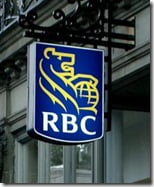 Something unusual happened in the past two weeks.
Something unusual happened in the past two weeks.
On November 17 most (but not all) of the banks raised their posted 5-year fixed rates from 5.19% to 5.44%.
Then, with little fanfare, they cut them back to 5.19%.
These quiet rate reductions were led in part by RBC, the nation’s biggest mortgage lender. On November 25, RBC brought its 5-year posted rate back to 5.19%. (Despite this posted rate reduction, its actual client rates remained unchanged.)
The reduction in posted rates was quite counter-intuitive to some people. Normally when bond yields soar as they have been, posted mortgage rates go up, not down. So, to understand RBC’s thinking, we spoke with Anjel Van Damme, RBC’s Director of Pricing, Home Equity Financing Products.
Ms. Van Damme explained that the differential between posted and discount rates has been larger than in the past. (Indeed, before this move back to 5.19%, the posted-bond spread was 305 basis points, 36 basis points above the average since 1999.) Because of this, “RBC is trying to bring posted rates closer to client rates,” she said.
“People very often quote our posted rates and not our specials," Van Damme added. She said that is especially true with first-time home buyers. “First-time home buyers will often look at the posted rates and not realize just how competitive banks are.”
We feel it necessary to add a quick side note here. There are still lenders and brokers who regularly compare their deeply discounted rates to the banks’ posted rates, as if they can really save you 1.50% on your mortgage rate. It’s hard to fathom how these sorts of comparisons can be anything short of intentionally misleading.
In any event, Van Damme believes the Internet has changed the game. “Clients are becoming more and more aware of pricing. I think they shop more today.” Therefore, she says RBC intends to bring its posted rates much closer to its everyday discounted rates.
 If RBC’s advertised discount rates eventually do become its posted rates, it would be significantly less confusing to consumers. That’s the way banks like ING Direct have done it for years. “We want to become more transparent,” Van Damme states. “Whether we get as close to these lenders on our posted pricing, I'm not sure."
If RBC’s advertised discount rates eventually do become its posted rates, it would be significantly less confusing to consumers. That’s the way banks like ING Direct have done it for years. “We want to become more transparent,” Van Damme states. “Whether we get as close to these lenders on our posted pricing, I'm not sure."
Many will wonder why RBC keeps its posted rates at all. Van Damme says discounting off of posted rates “is a model that has worked for us in the past, but strategies can change over time.” She adds, “I'd have to look at all of our business goals” to see if a discounted rate strategy (is more effective).”
BMO, a major RBC competitor, seems to think it is more effective. BMO became overtly aggressive on pricing when it launched its “low frills” mortgage in March. As a result, it’s a sure bet that RBC has analyzed the success of BMO’s strategy very closely—as have other lenders. In fact, we wouldn’t be surprised if RBC came out with its own aggressive rate promotion(s) next year.
Van Damme does caution about one thing. Homeowners need to be very careful with some of these ultra-low rates, she says. Many of the “no-frills” rates are loaded with restrictions like pre-payment limitations, fully-closed terms, stripped-out features, or unusual penalties. “People really need to compare product to product. If they're not looking at what they’re giving up, they may regret it in the future.”
There’s also another interesting sideline to this story. If the other banks continue following RBC’s lead and bring posted rates closer to discounted rates, it could reduce the qualification rate used to approve people for variable and 1-4 year mortgages. Van Damme points out that, “Yes, that is possible. Although, it’s not something we look at when setting the posted rates. The qualification rate impacts only a small percentage of our clients.”
Rob McLister, CMT







I think RBC is smart to get rid of posted rates especially if they’re they first big bank to do it. Posted rates are totally meaningless except for cashback mortgages and qualification purposes. Oh ya, and penalty calculations.
rbc still has a posted rate
Three random thoughts:
1.) Lowering the posted rate reduces the gap between bank prepayment penalties and monoline lender penalties (which are substantial). Could part of the reasoning for this move be an attempt to soften the changes to mortgage penalty disclosure rules being considered by Finance Minister Flaherty, and which he promised to make in this year’s budget speech?
2.) The current qualifying rate is way too high, and lowering the posted rates which it is based on will partly address the issue. I think that’s a signficant factor in making this change, and yes, I’m aware that not all of the banks have followed, but we all know how this will play out. While it’s a decent short-term solution to the problem, I’m still not crazy about the fact that the Big Six is essentially setting the qualifying rate (since it is based on the average posted rates of this group), and with a rate they don’t even use for lending. I would much rather see a real-market-rate average that is grossed-up by a prescribed amount.
3.) Rob, you’re right about using the bank posted rates for comparison. I’ve been doing it on my site, but it was just by force of habit. I’m going to take mine off in the morning and just publish my rates. Good call.
RBC will continue to have higher posted rates for the foreseeable future. This is a shift that will potentially take place down the road. Cheers… Rob
Hi David,
Regarding comparing broker rates to posted bank rates, when we first got in the business we did the same. We stopped once we realized that only people who can’t read their renewal forms pay posted rates. :)
While not ideal, it’s certainly more reasonable to quote the bank’s lowest or median “special offer” rate–currently 4.04% on a full-featured 5-year fixed. That’s because some people actually do pay those rates (God help them)…even though other customers get discretionary discounts.
Cheers,
Rob
It is not unusual for the Banks themselves to publish both the posted rate and their so called better than prime or deep discounted rate so why should Mortgage Brokers be any different.
Hi Mike,
Posted rates are an anachronism and banks don’t post them to solicit business. When a lender/broker compares its deep discounted rates to a bank’s posted rates (which virtually no customers pay), it’s like Expedia comparing their discounted hotel prices to a hotel’s rack rates, or a car dealer comparing their invoice price to another dealer’s MSRP.
Most mortgage planners would rather portray the most accurate possible data to potential customers. Most clients are quite savvy and can easily be turned off by seemingly misleading advertising.
Cheers,
Rob
“Van Damme says discounting off of posted rates is a model that has worked for us in the past”
What model is that? That some people still pay posted rates on renewal because that is all the bank offers on their renewal forms? or that it allows the bank to sometimes pad the IRD penalty on early terminations?
Many years ago, we pulled all the fancy Electronic rate boards from the branch entrances since the walk-in public was getting confused over the posted rates and thought that all we offered was uncompetative rates.
Today, I see no legitimate reason to still have posted rates except to screw over the less informed on rates.
Hi Banker, I think sentiments like yours are precisely why posted rates may eventually go the way of the dodo. -rm
To me the most interesting development of losing posted rates would be on the qualifying rates for VRMs and under 5 year terms.. Seems like the big 5 all have the same posted rates, with wide variations in the discounted rates. How would they get around this? I guess we will have to wait and see…
Typically the interest rates that are offered on BTL mortgages are fairly close to residential mortgage rates but will on average be higher and typically charge higher fees. This is due to the perception amongst banks and other lending institutions that BTL mortgages represent a greater risk than residential owner-occupier mortgages.
=====================
I agree 100% with Jim’s post up above. Posted rates really mean very little in the grand scheme and banks should start posting their actual rates.
Jeff
In the bizarre land of Canadian Mortgages, I don’t understand why anyone even uses a Big Bank ?? I have used a broker to find the best / better deal for 6 different homes over the last 30 years and found they could out do ANY offer the Big Bank could come up with. Then you learn that the outfit that just gave you a good deal is actually a subsidiary of one of the big banks. Exactly what is going on here, they make piles of money from mortgages, but it appears there are a lot of hidden ways they do this. I don’t think their rates listed have ever been valid nor will they ever be. They are too busy deciding if your a “worthy” risk and if you are “worthy” then they offer a rate at what they deem is either excellent, good, fair, or pay through the nose.